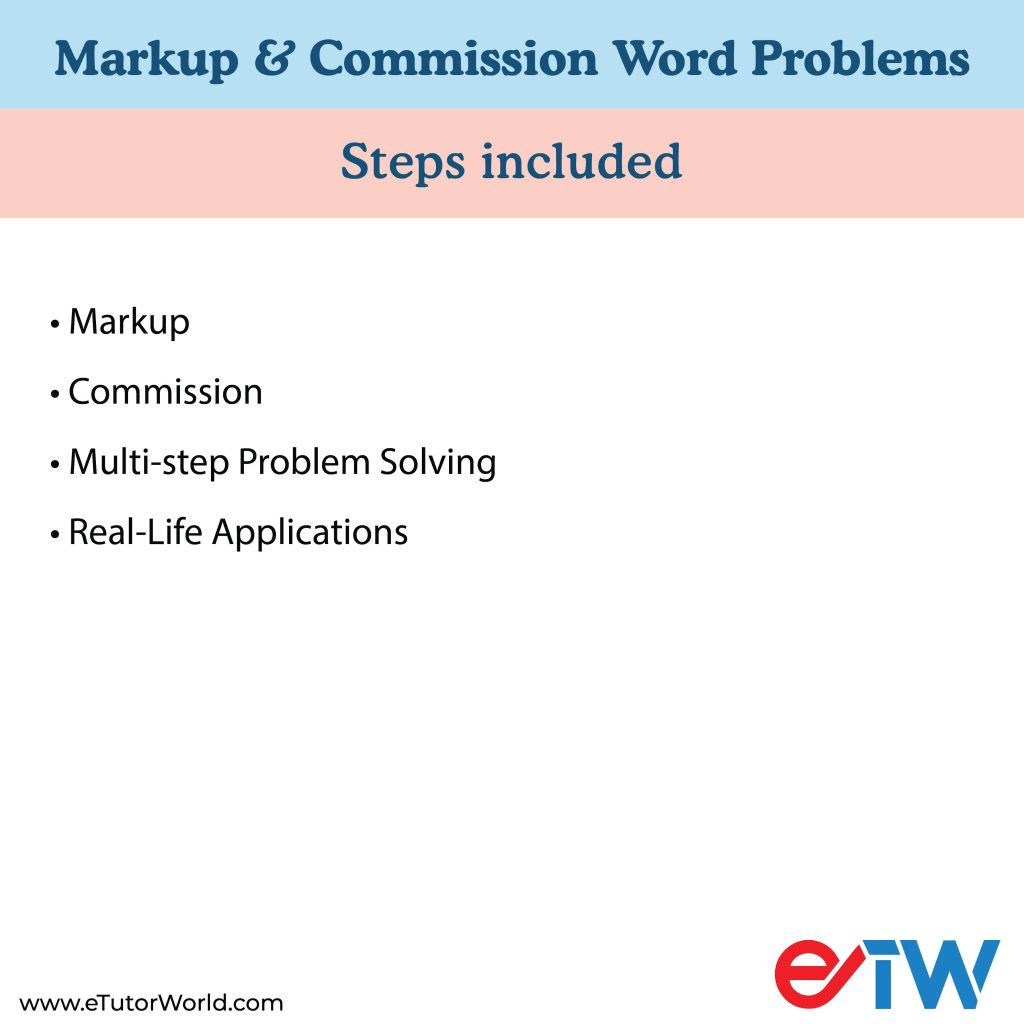Markup and Commission Word Problems
Grade 7 Math Worksheets
Understanding markup allows us to determine the selling price of products, while commission helps calculate earnings based on sales. Through engaging word problems and step-by-step explanations, we will unravel the intricacies of these concepts, equipping students with the skills to solve problems encountered in everyday life
Understanding the concepts of markup and commission is crucial. By solving these problems, students develop their problem-solving abilities, and critical thinking skills, and gain insight into the financial aspects of transactions. Here are the key components of markup and commission word problems:
Table of Contents:
- Markup
- Commission
- Formula
- Solved Examples
- FAQs
Personalized Online Tutoring
Markup and Commission Word Problems - Grade 7 Math Worksheet PDF
This is a free worksheet with practice problems and answers. You can also work on it online.
Sign up with your email ID to access this free worksheet.
"We really love eTutorWorld!"
"We really love etutorworld!. Anand S and Pooja are excellent math teachers and are quick to respond with requests to tutor on any math topic!" - Kieran Y (via TrustSpot.io)
"My daughter gets distracted easily"
"My daughter gets distracted very easily and Ms. Medini and other teachers were patient with her and redirected her back to the courses.
With the help of Etutorworld, my daughter has been now selected in the Gifted and Talented Program for the school district"
- Nivea Sharma (via TrustSpot.io)
Markup:
Markup refers to the amount added to the cost price of a product to determine its selling price. In markup word problems, students are tasked with finding the selling price or determining the markup percentage based on given information.
Understanding how to calculate markup helps in determining appropriate pricing strategies and profit margins in business.

Commission:
The commission represents a percentage or fixed amount earned by an individual based on sales. In commission word problems, students are challenged to calculate the commission earned by a salesperson or determine the total sales needed to reach a specific commission. These problems provide insight into how earnings can be tied to performance and sales in real-world scenarios.
Multi-step Problem Solving:
Markup and commission word problems often require multi-step problem-solving strategies. Students must analyze the problem, identify the relevant information, determine the appropriate formulas or calculations to use, and execute the steps in a logical sequence to arrive at the solution. These word problems enhance critical thinking skills and reinforce the importance of systematic problem-solving approaches.
Real-Life Applications:
Markup and commission are encountered in various industries and professions. Understanding these concepts prepares Grade 7 students for future financial literacy and business-related endeavors. From retail to sales and entrepreneurship to finance, the ability to solve markup and commission word problems lays the foundation for understanding the economic aspects of transactions and their impact on profit and earnings.
Formula
Markup Formula:
Markup refers to the amount added to the cost price of a product to determine its selling price. The formula to calculate the selling price with a given markup percentage is:
Selling Price = Cost Price + (Markup Percentage * Cost Price)
Alternatively, the formula to calculate the markup percentage given the selling price and cost price is:
Markup Percentage = ((Selling Price – Cost Price) / Cost Price) * 100
Commission Formula:
Commission represents a percentage or fixed amount earned based on sales. The formula to calculate the commission earned is:
Commission = Sales Amount * Commission Rate
In this formula, the sales amount is the total value of the sales made, and the commission rate is the percentage or fixed amount earned on each sale.
Alternatively, the formula to calculate the sales amount needed to reach a specific commission is:
Sales Amount = Commission / Commission Rate
This formula helps determine the total sales required to achieve a desired commission.
“There have been times when we booked them last minute, but the teachers have been extremely well-prepared and the help desk at etutorworld is very prompt.
Our kid is doing much better with a higher score.”
7th Grade Tutoring
eTutorWorld offers Personalized Online Tutoring for Math, Science, English, and Standardised Tests.
Our Tutoring Packs start at just under $22.49 per hour, and come with a moneyback guarantee.
Schedule a FREE Trial Session, and experience quality tutoring for yourself. (No credit card required.)
Solved Examples
Example 1: Markup
A store purchases a shirt for $20 and wants to apply a 25% markup. What will be the selling price of the shirt?
Solution:
Given:
Cost Price = $20
Markup Percentage = 25%
Using the markup formula:
Selling Price = Cost Price + (Markup Percentage * Cost Price)
Selling Price = $20 + (0.25 * $20)
Selling Price = $20 + $5
Selling Price = $25
The selling price of the shirt will be $25.
Example 2: Commission
A salesperson earns a 7% commission on total sales. If their sales amount is $5,000, how much commission will they earn?
Solution:
Given:
Sales Amount = $5,000
Commission Rate = 7%
Using the commission formula:
Commission = Sales Amount * Commission Rate
Commission = $5,000 * 0.07
Commission = $350
The salesperson will earn a commission of $350.
Example 3: Finding Sales Amount
A salesperson wants to earn a commission of $400 at a 5% commission rate. What should be their total sales amount?
Solution:
Given:
Commission = $400
Commission Rate = 5%
Using the formula to find the sales amount:
Sales Amount = Commission / Commission Rate
Sales Amount = $400 / 0.05
Sales Amount = $8,000
The salesperson needs to achieve a total sales amount of $8,000 to earn a commission of $400 at a 5% commission rate.
Do You Stack Up Against the Best?
If you have 30 minutes, try our free diagnostics test and assess your skills.
FAQs
What is markup?
Markup refers to the amount added to the cost price of a product or service to determine its selling price. It represents the profit or margin added to cover expenses and generate revenue. The markup percentage is calculated by dividing the markup amount by the cost price and multiplying by 100. Markup is commonly used in retail and business settings to establish the selling price of goods and services.
What is commission?
Commission is a percentage or fixed amount earned by an individual based on the value of sales made. It serves as a form of incentive or compensation for generating sales or completing transactions. The commission rate represents the percentage or fixed amount applied to the sales value to determine the commission earned. Commission is prevalent in sales and business environments where individuals are rewarded based on their performance and contribution to revenue generation.
How do I calculate the selling price with markup?
To calculate the selling price with markup, use the formula:
Selling Price = Cost Price + (Markup Percentage * Cost Price)
Multiply the cost price by the markup percentage (expressed as a decimal), then add the result to the cost price. The final value represents the selling price, including the markup.
How do I calculate commission earnings?
To calculate commission earnings, use the formula:
Commission = Sales Amount * Commission Rate
Multiply the sales amount by the commission rate (expressed as a decimal) to obtain the commission earnings. The result represents the amount earned based on the sales made.
How can I use markup and commission in real life?
Markup and commission have practical applications in various real-life scenarios. Markup is used in retail and business to determine selling prices and profit margins. Understanding markup helps in pricing products, managing profit, and setting competitive prices. Commission is prevalent in sales roles, where individuals earn a percentage or fixed amount based on their sales performance. It provides motivation, incentivizes sales efforts, and aligns earnings with sales outcomes. Both concepts are essential in business, finance, and entrepreneurship, and understanding them contributes to financial literacy and effective decision-making.

Gloria Mathew writes on math topics for K-12. A trained writer and communicator, she makes math accessible and understandable to students at all levels. Her ability to explain complex math concepts with easy to understand examples helps students master math. LinkedIn
Affordable Tutoring Now Starts at Just $22.49
eTutorWorld offers affordable one-on-one live tutoring over the web for Grades K-12. We are also a leading provider of Test Prep help for Standardized Tests (SCAT, CogAT, MAP, SSAT, SAT, ACT, ISEE, and AP).
What makes eTutorWorld stand apart are: flexibility in lesson scheduling, quality of hand-picked tutors, assignment of tutors based on academic counseling and diagnostic tests of each student, and our 100% money-back guarantee.
Whether you have never tried personalized online tutoring before or are looking for better tutors and flexibility at an affordable price point, schedule a FREE TRIAL Session with us today.
*There is no purchase obligation or credit card requirement
Grade 7 Science Worksheets
- Elements and Compounds
- Solar Energy
- Photosynthesis
- Electricity and Magnetism
- Law of conservation of energy
- Periodic table
- Properties of Matter
- Waves
- Energy Resources
- Weather and Climate
- Immune, Circulatory and Digestive Systems
- Organs in Multi-cellular Organism
- Sedimentary, Igneous, and Metamorphic Rocks
- Structure of the Earth
- Law of Conservation of Mass
- Physical and Chemical Changes
- Scientific Method
- Human Digestive System
- Environmental Science
- Renewable and Non-renewable energy Resources
- Characteristics of Living Organisms
- Life Science
- Earth and Space Science
- Solar Eclipse
- Heat Technology
- Newton’s Laws of Motions
- Physical Science
- Tools, Measurement and SI Units
- Earth Atmosphere
- Interactions of Living things
- The Earth Ecosystem
- Organelles in Plant and Animal cells
- Layers of the Earth
- Cycles in Nature
Grade 7 Math Worksheets
- Fractions
- Linear equations word problems
- Statistics
- Properties of Parallel Line
- Finding slope from an equation
- Identifying Quadrilaterals
- Percent Change
- Properties of addition and multiplication
- Pythagorean Theorem
- Solving two step inequalities
- Symmetry
- Fractions to Decimals (New)
- Whole Number Exponents with Integer Bases (New)
- Adding and Subtracting Fractions (New)
- Integer Addition and Subtraction (New)
- Dividing Mixed Numbers (New)
- Basics of Coordinate Geometry (New)
IN THE NEWS

Our mission is to provide high quality online tutoring services, using state of the art Internet technology, to school students worldwide.
Online test prep and practice
SCAT
SSAT
ISEE
PSAT
SAT
ACT
AP Exam
Science Tutoring
Physics Tutoring
Chemistry Tutoring
Biology Tutoring
Math Tutoring
Pre-Algebra Tutoring
Algebra Tutoring
Pre Calculus Tutoring
Calculus Tutoring
Geometry Tutoring
Trigonometry Tutoring
Statistics Tutoring
Quick links
Free Worksheets
Fact sheet
Sales Partner Opportunities
Parents
Passive Fundraising
Virtual Fundraising
Our Expert Tutors
Safe and Secure Tutoring
Interactive Online Tutoring
After School Tutoring
Elementary School Tutoring
Middle School Tutoring
High School Tutoring
Home Work Help
Math Tutors New York City
Press
©2022 eTutorWorld Terms of use Privacy Policy Site by Little Red Bird
©2022 eTutorWorld
Terms of use
Privacy Policy
Site by Little Red Bird









